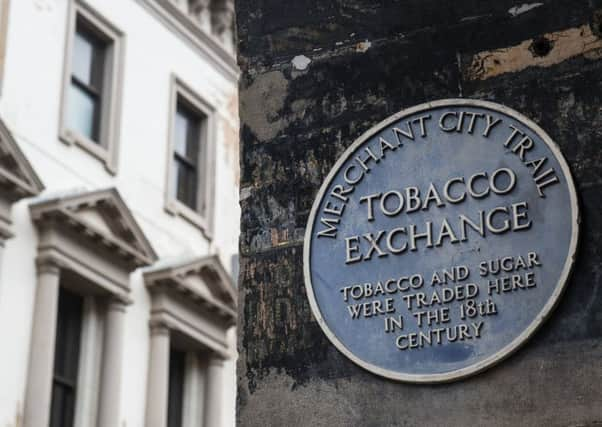Scotland’s slave trade ties are writ large in story of Hairstons


The disdain and complacency of her critics merely betrays their ignorance, and it is particularly grating in a month marking the 400th anniversary of the arrival of the first African slaves in the British colony of Virginia.
The poet is right to point out that in 2019, the average Scottish child will be unaware of how Glasgow’s grand cityscape was built on proceeds from the slave trade. But neither will they, nor the vast majority of their parents, realise the long-forgotten role one Scots emigrant played in American slavery.
Advertisement
Hide AdAdvertisement
Hide AdI have spent several months developing a documentary project about the Hairstons, a fascinating family which, at one point, had one of the largest slaveholdings in the antebellum south. Its historic patriarch, Peter Hairston, was born in Dumfries in the twilight of the 17th century, and became a loyal Jacobite. But after the Battle of Preston in 1715, he fled to Ireland before emigrating to the American colonies with his wife and five children.
They settled in Virginia, where Hairston and his sons secured 400 acres of fertile land for a tobacco plantation in Goochland County, and a succession of slaves to work it.
From that modest holding of the man known nowadays as Peter the Immigrant, an empire grew. Within the space of three generations, the Hairstons came to own around 10,000 slaves across 45 plantations spanning four southern states.
The wealth they accrued was dizzying. An 1851 edition of the Richmond Whig and Public Advertiser newspaper declared Samuel Hairston – Peter’s great grandson – to be the “richest man in Virginia”.
A census showed he owned between 1,600 and 1,700 slaves, and with plantations across Virginia and North Carolina, it is estimated he was worth as much as $5million.
These are familiar traits of the Hairston story – fortunes forged on the back of human misery, preserved by rape, coercion, and concubinage, and recorded in meticulous detail in ledger books referencing the dollar value of each man, woman, and child.
Yet the narrative is altogether more complex in places, such as the story of Samuel’s brother, Robert, who had secured his own sprawling plantation estate by the time he lay on his deathbed in 1852.
One of his final acts was to rewrite his will to emancipate his only child, a slave girl called Chrillis, and leave her his entire fortune. But in a country on the verge of war, such a bequest could never stand. The courts denied Chrillis her inheritance and her freedom.
Advertisement
Hide AdAdvertisement
Hide AdSuch stories are extraordinary but not exceptional. Countless slave children were given the family name and, in time, formed clans of their own.
Not all found brighter futures. One of the family’s most prominent living members, Ever Lee Hairston, was born on Cooleemee, a North Carolina plantation where the Hairstons had once enslaved 300 people.
Many, if not all, left after abolition. Those who stayed included Ever Lee’s house servant grandparents. Their children did likewise, working as sharecroppers.
Even though the Civil War had ended nearly a century previously, Ever Lee was expected to follow suit when she was born in 1942. She spent her early years picking cotton and sleeping in an old slave cabin, before fleeing as a teenager, having realised her family had been effectively brainwashed.
The youngest generation of Hairstons share her determination to provide a warts and all account of the past. Princess Hairston, an Emmy-nominated film editor from New York, is working on a film about the white and black descendants of Peter the Immigrant.
She hopes in time to screen the completed feature in Dumfries. That is, after all, where the story began, and the family’s Scottish roots have long provided its white lineage with a conveniently innocuous backstory. “A lot of white Hairstons weren’t told the family history about how they were one of the biggest slaveowners,” Princess told me. “The Scottish heritage became something they emphasised to look at their past in a different way.”
None of these hard truths would have been realised were it not for the prodigious research of Henry Wiencek, who wrote a spellbinding 1999 history of the family, and Peter Wilson Hairston, the sixth generation owner of Cooleemee and a former Superior Court judge.
Before his death in 2007 at the age of 93, he availed himself of the sprawling Hairston archives, compiling a history which shone a light on dark places and secured a rapprochement between two families who, through slavery, were one.Earlier this month, the National Hairston Clan held its 46th annual reunion, with its members gathering at Cooleemee, where their descendants once toiled, suffered, and often against their will, ensured the continuance of an astonishing legacy.
Advertisement
Hide AdAdvertisement
Hide AdVery few people in the Hairstons’ ancestral homeland will be aware of their story, but if they have found the strength to overcome the lies, mythmaking and silence that for so long obscured the truth, we in Scotland should draw inspiration and ensure we too ask ourselves some searching questions, no matter how uncomfortable the answers.